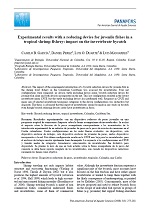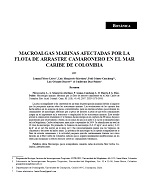
ABSTRACT. Diel-associated changes of catch rates and size-structure of shrimp (Farfantepenaeus notialis and F. brasiliensis), incidental catches, discards and the twelve most caught fish species of each of the two shrimp trawling fishing zones (northern and southern) of the Colombian Caribbean Sea were examined. Data were obtained by on board observers between July...
30/05/2018

Effects of the fisheye bycatch reduction device (BRD) and turtle excluder device (TED) on shrimp retention and bycatch reduction were assessed, aiming to increase sustainability and attenuate the ecological impact of shrimp trawls in the Colombian Caribbean Sea. A total of 88 hauls were carried out in two different periods. The four...
30/05/2018

The impact of the experimental introduction of a bycatch reduction device for juvenile fish in the shrimp trawl fishery in the Colombian Caribbean was assessed for invertebrates. Four net configurations were compared: no device, turtle excluding device alone, bycatch reduction device for juvenile fish alone and both devices incorporated on the...
30/05/2018

The bycatch from shrimp trawling has become a matter of concern due to the impact of fisheries on marine ecosystems. Several studies have emphasized the impacts of shrimp trawling on fish and invertebrates, but very little is known about the effects on seaweed communities, despite their critical role in the structure and function...
30/05/2018

ECOSIM simulations of the introduction of bycatch reduction devices (BRD) to a tropical industrial shrimp fishery resulted in moderate to strong positive changes of biomass of selected bycatch functional groups, depending on the position of the BRD in the trawl net. The highest increases in biomass after 20 years of simulation were...
30/05/2018

The Fisheries Assessment and Ecology Information System (SIEEP) was constructed to validate, standardizeand store biotic and abiotic information for ecological, oceanographic and fisheries studies. Since bycatchstudies are required in the shrimp trawl fisheries, the SIEEP has been updated to store fisheries and biologicaldata from bycatch samples analysed on board and...
30/05/2018

In order to have an approximation to the cartilaginous fishes assemblage structure exploited by commercial shrimp trawlers from the north coast of Colombia, composition and abundance of the discarded sharks and rays on two zones of the Colombian Caribbean, between August and November of 2004 were evaluated. Each month, a number of trawls...
30/05/2018

In Colombia, Solenocera agassizi is a species that supports the Deep Water Shrimp (DWS) fishery operating in the Pacific, and is one of the most relevant for the national economy. Knowledge of reproductive aspects is essential for resource conservation, and to date little information has been published concerning the distribution of the...
30/05/2018

Penaeid shrimp fisheries are an important source of income for the fishing communities that live in estuarine zones around the world. Off Buenaventura, the habitat of the western white shrimp (Litopenaeus occidentalis) is subject to high precipitation associated with the intertropical convergence zone, contributions from numerous short rivers descending from the Andes...
30/05/2018

Poster on the REBYC-II LAC project in Colombia
*Available only in Spanish
09/05/2018
